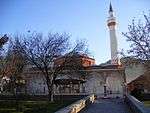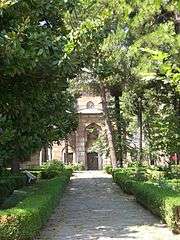Hüsnüşah Hatun
| Hüsnüşah Hatun | |||||
|---|---|---|---|---|---|
|
Ümdet-ül- muhadderat Tâc-i mestürat Iklilet-i Aliyyet-üz-zat | |||||
|
The mausoleum of "Hüsnüşah Hatun" is located inside Muradiye Complex, Bursa | |||||
| Born | Karamanid Principality | ||||
| Died |
c. 1513 Bursa, Ottoman Empire | ||||
| Burial | Muradiye Complex, Bursa | ||||
| Spouse | Bayezid II | ||||
| Issue |
Şehzade Şehinşah Sultanzade Sultan | ||||
| |||||
| House | House of Osman (by marriage) | ||||
| Father | Nasuh Bey | ||||
| Religion | Sunni Islam | ||||

Hüsnüşah Hatun was the Empress of the Ottoman Empire as the wife of Sultan Bayezid II.
Life
Hüsnüşah Hatun was born in 1454 to a Nasuh Bey. Bayezid was still a şehzade and the governor of Amasya sanjak when she gave birth to Şehzade Şehinşah in 1474, followed by Sultanzade Sultan.
According to Turkish tradition, all princes were expected to work as provincial governors as a part of their training. In 1481 Şehinşah, was sent to Manisa sanjak and then in 1483 to Karaman, and Hüsnüşah accompanied him. She built and endowed a mosque at Manisa in 1490.
After Şehzade Şehinşah's death in 1511, Hüsnüşah Hatun came to Bursa. Hüsnüşah Hatun also corresponded with Selim I, Şehinşah's victorious brother, on behalf of Mevlana Pir Ahmed Çelebi, a scholar who had been at Şehinşah's court and who was neglected when the members of the prince's household were assigned new posts. She lies buried in Muradiye Complex, Bursa.
References
Bibliography
- M. Çağatay Uluçay (1985). Padişahların kadınları ve kızları. Türk Tarih Kurumu.
- Necdet Sakaoğlu (2008). Bu mülkün kadın sultanları: Vâlide sultanlar, hâtunlar, hasekiler, kadınefendiler, sultanefendiler. Oğlak Yayıncılık. ISBN 978-9-753-29623-6.
- Leslie P. Peirce (1993). The Imperial Harem: Women and Sovereignty in the Ottoman Empire. Oxford University Press. ISBN 978-0-195-08677-5.
